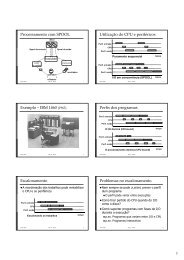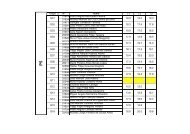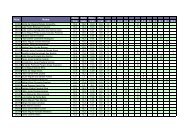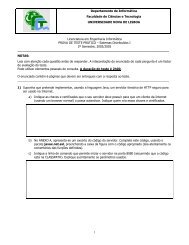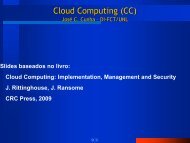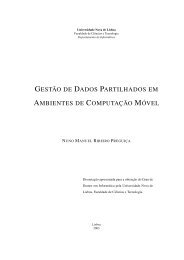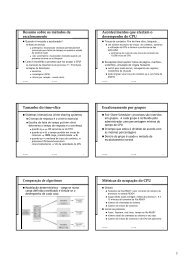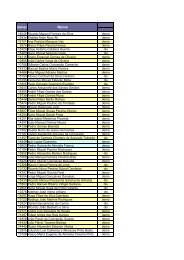Dissertaç ˜ao de Mestrado Mestrado em Engenharia Informática Jo ...
Dissertaç ˜ao de Mestrado Mestrado em Engenharia Informática Jo ...
Dissertaç ˜ao de Mestrado Mestrado em Engenharia Informática Jo ...
Create successful ePaper yourself
Turn your PDF publications into a flip-book with our unique Google optimized e-Paper software.
3. AN APPLICATION RECONFIGURATION FRAMEWORK 3.3. Original to Generic syntax Converter<br />
Listing 3.1: User Interface proposed interface<br />
interface UI {<br />
void processFiles(String[] fileNames);<br />
void submitGrammar();<br />
byte[] getTentativeGrammar();<br />
void approveParser();<br />
boolean importParser();<br />
void haltSession();<br />
void recoverSession();<br />
}<br />
<strong>de</strong>scribed. The interfaces that every component should impl<strong>em</strong>ent are also presented, in a<br />
Java-like syntax. Enforcing every component to impl<strong>em</strong>ent an interface not only allows any<br />
component to be completely r<strong>em</strong>a<strong>de</strong> without having any effect on other components, it also<br />
aids the integration process of SmART with other tools.<br />
User Interface<br />
The User Interface (UI, Listing 3.1) is the tool’s front-end, through which the user interacts with<br />
the tool. It is invoked by the user and receives an array of configuration file locations at boot<br />
time, although it only processes one at a time.<br />
For each file, UI summons the Configuration File Parser to make an att<strong>em</strong>pt at<br />
parsing a configuration file with the parsers in the Parser Repository. Two outcomes are<br />
possible: either a parser manages to recognize the totality of a file or none does.<br />
The first case is the i<strong>de</strong>al case, where at least one of the parsers in the Parser Repository<br />
manages to fully recognize the configuration file. In this situation, UI displays the representa-<br />
tion of the generic syntax, as returned by the Configuration File Parser, to let the user<br />
validate the generated structure. At this point, the configuration file in generic syntax is stored<br />
in m<strong>em</strong>ory, so UI must save it to a file to let file modification take place.<br />
The second case, where the configuration file was not completely parsed by any available<br />
parser, requires user intervention. If the file could not be totally recognized by any parser,<br />
another parser which recognizes this new language must be generated. For this en<strong>de</strong>avour,<br />
UI provi<strong>de</strong>s the user with a friendly interface which allows him to <strong>de</strong>fine a new grammar<br />
that recognizes the configuration file language. The user must also be allowed to build a new<br />
grammar from an existing one. This is useful in the case where a parser managed to parse a<br />
configuration file almost entirely. In this case, the new parser might be ready just by tuning an<br />
existing one, instead of having to build it from scratch.<br />
As soon as a grammar is <strong>de</strong>fined, the user triggers its compilation with the Grammar<br />
Compiler’s submitGrammar call. Any grammar compilation errors should be displayed to<br />
the user. To ease parser generation, the user must have access to the previously tested gram-<br />
mars. This allows for the rollback of changes in grammars in an easy way. To accomplish<br />
this, every time the user submits a new grammar, UI sends it to the Tentative Grammar<br />
27



